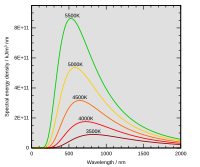
Photo from wikipedia
The detection of changes in the morphological and chemical structure of four cotton/polyester blend fabrics and their constituent fibres caused by thermal radiation was the purpose of the study. Relatively… Click to show full abstract
The detection of changes in the morphological and chemical structure of four cotton/polyester blend fabrics and their constituent fibres caused by thermal radiation was the purpose of the study. Relatively short exposure times, i.e., 20 s, 25 s, 30 s and 40 s, of fabrics for an incident heat flux density of 10 kW/m2 were applied so that they did not cause changes visible to the naked eye. Such experimental conditions have been selected to resemble the ones that may occur during firefighting, rescue operations, some professional activities as well as during criminal events. The assumption that using the sequence of physicochemical methods, i.e., optical microscopy, scanning electron microscopy and FTIR spectroscopy, will make it possible to identify selected thermal changes in examined materials caused by a short-term temperature increase has been positively verified. Out of applied techniques, scanning electron microscopy showed the highest efficiency in tracking morphological changes in fibres occurring under the influence of heat radiation, while the FTIR method allows for the identification of thermal changes in the chemical structure of cotton fibres. Optical microscopic methods were also characterised by relatively high usefulness in the detection of thermal changes, especially in terms of the physical microstructure of PES fibres. The changes occurring in the fibres due to the action of heat radiation depend not only on the thermal behaviour of a particular type of fibre but also on the structural parameters of the examined textiles, i.e., porosity, and the mutual position of particular types of fibres in the three-dimensional structure of yarns and fabrics. Moreover, the studies revealed the presence of tiny, deformed balls at the ends of the thermoplastic fibres, visible on the surface of some original polyester-cotton textiles, caused by a singeing technological process, which should be taken into account during interpretation of analytical findings.
Journal Title: Applied Sciences
Year Published: 2021
Link to full text (if available)
Share on Social Media: Sign Up to like & get
recommendations!